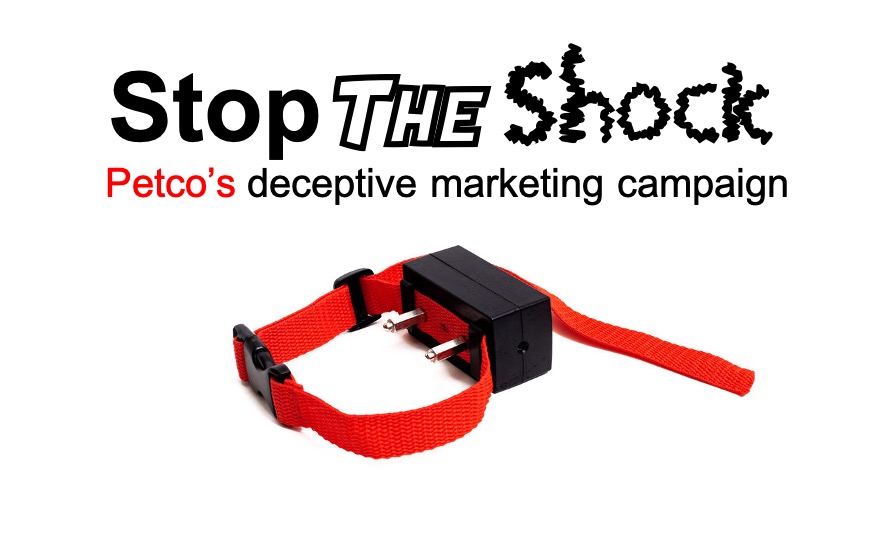Canine News You Can Use
Stop the Shock: Petco’s Deceptive Marketing Campaign (Part 1)

On October 6, 2020, Petco decided to make changes to the products they sell, eliminating the sale of electronic collars (e-collar) “operated by a person with a remote in hand.” This was a major marketing campaign designed to position Petco as a Health and Wellness organization for pets. Unfortunately, the campaign included much misinformation related to the use of e-collars. Blue Bridge Dog Training advocates for the proper use of e-collars, but we must set the record straight for all the dog owners who have now received a one-sided narrative from this campaign.
For complete transparency, first let me disclose how e-collars are part of Blue Bridge Dog Training.
1) I am an authorized dealer for a well-respected brand of e-collars (not sold at Petco). Sales for e-collars and e-collar components is a miniscule part of the business, and I have sold three year-to-date. If I stopped selling e-collars today, it would have zero impact on the business.
2) I have only sold e-collars to clients. I will not sell an e-collar without the purchaser going through a training session that I provide at no cost.
3) I have used an e-collar to stop unwanted behaviors like chasing animals and coprophagia (kop-ruh-fey-jee-uh), or poop eating. A systematic process is always followed, and other remedies are usually attempted prior to the e-collar. And yes, I have used an e-collar on one of my personal dogs to deter animal chasing (squirrels, cats, chickens, ducks). He now runs and plays on our property with no collar at all most of the time, and I have not had an e-collar on him since.
In the letter from Petco CEO, Ron Coughlin, these statements were made (emphasis added):
“Today, we stop the pain for Buddy because he barks at the doorbell.”
“We stop the stress for Sadie because she jumps for joy all over the neighbors when they walk in the door.”
“And we stop the fear for Cooper because he prefers a good pair of sneakers over all the chew toys on the market.”
This assumes that the use of an e-collar causes pain, stress, and fear, by design. These statements have conveniently omitted the use of low-level stimulation to communicate with a dog, without causing pain, stress, and fear. Additionally, where higher levels are used to stop a behavior, it is done methodically with the best interest of the dog (and in some cases, humans) in mind. It is not “cranked up to the max to teach the dog a lesson.” Sadie “jumps for joy all over the neighbors,” is a misleading statement (why use the word joy?) that downplays the seriousness of the behavior. We can hardly use the word “joy” when Sadie knocks eighty-year-old grandma over, breaking her hip. Perhaps for Sadie, but it is certainly not joyful for grandma. As many dog owners know, a trip to the veterinarian can cause pain, stress, and fear. So, do we stop taking our dogs to the vet? Of course, we do not. We are doing what is best for our dogs.
The letter continues:
"So today, we say out with shock collars and in with POSITIVE TRAINING."
"We say goodbye to remote controls that cause pain, and hello to expert trainers who mentor pets and pet parents with positivity, patience and compassion."
(Additionally, from Petco web site under Dog Training: "We believe in the power of positive reinforcement training, guided by expert tested methods meant to build trust and support your dog’s physical, social, and mental health.")
In these statements there are three points made that are effective marketing but are misleading for someone unaware of the entire story.
1) As previously mentioned, e-collar usage includes low-level stimulation that does not cause pain, stress, and fear. This is again conveniently omitted.
2) They use “expert trainers who mentor pets and pet parents with positivity, patience and compassion.” I submit that there are expert trainers who use e-collars, at least matching whatever level of positivity, patience, and compassion the Petco expert trainers supposedly have. The e-collar trainers that come to mind are Robin MacFarlane, Jamie Penrith, Ivan Balabonov. Watch the videos below to see if the dogs (trained with e-collars) in the videos are experiencing pain, fear, and stress. The Ivan Balabanov video is of particular interest because he directly addresses Victoria Stillwell’s perspective, with her quoting at the beginning of the video: “People who use this disgust me.” She indicts not only trainers, but well-intentioned Petco customers of evil intent. She is a supporter of Petco’s campaign.
And just for a little perspective, Ivan Balanov’s credentials include:
-
World Champion – International Dog Federation (FCI) All Breeds IPO3
-
World Champion – Belgian Shepherd World Federation (FMBB) IPO3
-
National Champion Seven-time American Working Dog Federation (AWDF) IPO3
-
National Champion Five-time American Working Malinois Association (AWMA) IPO3
-
National Champion United Schutzhund Clubs of America German Shepperd IPO3
3) When Petco states, “We believe in the power of positive reinforcement training…,” it implies that trainers using e-collars do not. Again, this is a misleading statement for the general public. My approach and the approach of other professional trainers I know ALWAYS includes positive reinforcement. This is a blog post I wrote about positive reinforcement:
5 Things You Should Know About Positive Reinforcement
And finally:
“Today, we encourage anyone using or looking for shock collars to consider training with treats instead of electricity and partnership instead of pain.”
“In fact, we’ll cover your first positive training class if you’ll let us.”
I believe that the two sentences above summarize the entirety of Petco’s marketing campaign.
1) “…consider training with treats instead of electricity”: This little gem of a statement is both misleading and self-serving. To use the word electricity is to grossly mischaracterize the sensation of an e-collar. I recently changed the UV bulbs in a bug zapper (it was unplugged), forgetting to discharge the latent electricity that had built up in the metal rods. When that built up charge of electricity hit the tip of my finger, I was in split-second, severe pain. I ran cold water over my finger to try and minimize any potential skin damage, and it did not feel normal again for about 10-15 minutes. Contrast that to the sensation of an e-collar. Without actually buying an e-collar, you can get a very close approximation (if not exact) sensation by testing a 9-volt battery (for toys, small electronics) with your tongue. I did this all the time as a kid and still do it today. The amount of sensation you will feel depends on the age of the battery and how much it has been used. The two sensations I described are nothing alike, but Petco would like you to believe that the sensation of an activated e-collar is more in line with my bug zapper experience. Why else would they use the word, “electricity?”
2) So, instead of using “electricity” (covered above), you need to use treats. They have already established that they have expert trainers who don’t use pain (using “partnership” is a nice touch). Let’s see, where would you go to buy treats for training? Hmmm.
3) Offering a free “positive training class” gets you one step closer to paying for a Petco class and purchasing Petco treats for the foreseeable future.
Petco could have very easily come out with a simple statement instead of a marketing campaign related to their sale of e-collars, if it was only a matter of product versus philosophy misalignment. It would have been as simple as, “The sale of e-collars in our stores is not compatible with our training philosophy. Therefore, we will no longer offer e-collars as part of our product mix.” But they did not.
In Part 2, I will investigate their petition, “Help Petco #StoptheShock. Join Our Movement to Create Responsible Guidelines for Shock Collars.”
Do you have comments or questions? Let us know on Facebook: Stop the Shock: Petco’s Deceptive Marketing Campaign (Part 1)
Ready for Part 2? Read it here: Stop the Shock: Petco’s Deceptive Marketing Campaign (Part 2)
Automatically get notified of our blog updates and other stuff by signing up here: Subscribe Now (as a special bonus, you will also receive access to the “Wait Command Video” and a downloadable poster)
Breaking Through Barriers, Transforming Lives...
Jeff
